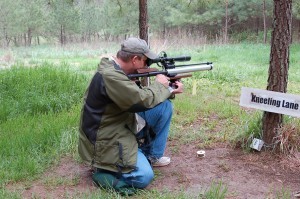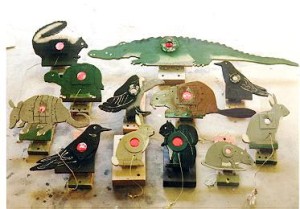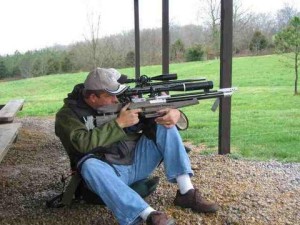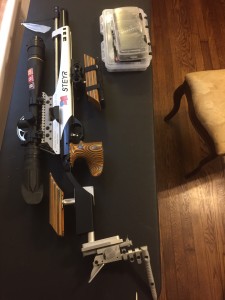There are many greats shooters in the history of field target. Since the sport isn’t all that old, some are still out there competing that started not too long after the inception of the sport. Every now and then we find one of those great shooters willing to share the secrets to their success. Mark Bassett (“Berty”) is one of those guys. Team Wild caught up to him a while back and was able to get some great tips on the sport of field target. Check out part 1 of the interview below with Mark. Enjoy!!
Archives
All posts for the month February, 2015
I recently had a chance to stop by and visit with Martin Rutterford at Rapid Air Weapons in Minor Hill, TN. Martin took time to show me around his CNC manufacturing facility, and we spent some time looking at the new TM1000. In short, the TM1000 is an awesome rifle that is designed with Field Target in mind. The rifle includes quite a few features that I find to be essential for Field Target. The optional new knee riser is rock solid, and can be used on most any other rifle with a rail.
Here’s a few photos of the TM 1000 in action!
David Brown’s new TM1000 in a 12 fpe version
[IMG]![[linked image]](http://i42.photobucket.com/albums/e322/playmasters/542a0999.jpg) [/IMG]
[/IMG]
[IMG]![[linked image]](http://i42.photobucket.com/albums/e322/playmasters/a3549a2f.jpg) [/IMG]
[/IMG]
Roz Sumpter with his new TM1000 in the 20 fpe version
[IMG]![[linked image]](http://i42.photobucket.com/albums/e322/playmasters/6ea31255.jpg) [/IMG]
[/IMG]
Knee Riser
[IMG]![[linked image]](http://i42.photobucket.com/albums/e322/playmasters/947ef7a0.jpg) [/IMG]
[/IMG]
[IMG]![[linked image]](http://i42.photobucket.com/albums/e322/playmasters/392f7a73.jpg) [/IMG]
[/IMG]
I think that offhand shooting is a very important part of the shooting discipline. Especially since we now see at least one offhand lane on each Field Target course that we shoot in the U.S. these days. Given that offhand is popular among match directors, it should be a pretty important part of your practice routine as well.
I used to practice primarily seated airgun shooting from the standard seated Field Target position. It is comfortable to me to shoot from the seated position and obiously easier than offhand or kneeling. So, I guess laziness took over and I would just go out and shoot a zillion shots from the seated position. Then when match day rolled around, I would go out and find at least one or two forced position lanes on every course. Usually one offhand and one kneeling lane is the norm. At first I was an average 50-60% offhand shooter and that meant that I was dropping a lot of shots on those lanes. Since most of our courses here in the South usually have three targets per lane or six shots per lane, that translates to 10% of a 60 shot match being offhand. Then if you add a kneeling lane, well there’s 20% of the match between the two lanes! Wow, that can add up fast… After using the practice techinques in this article, my offhand game has vastly improved. At the 2010 National match, I only missed one forced position shot out of twenty four on the course!
So, after shooting Field Target for a while, I realized that I needed to do something about my offhand game. My plan was simple. I forced myself to start practicing offhand every time that I practiced seated shooting. I tried to make it a point to simply shoot offhand first to get comfortable with the position. After a few days of offhand practice, I noticed that there were a few points that I should concentrate on in preparation for taking an offhand shot.
Good Position
First is a good foot position. When approaching an offhand lane on a Field Target Course, find a comfortable position for your feet. Clear the sticks, rocks or other debris away with your feet so that they are flat on the ground. Spread your legs to a position so that your feet are about shoulder width apart. Give yourself a slight angle to the target. I like to align my left leg and shoulder in line with the target. That puts me almost facing the lane to the right of me as I set up for an offhand shot. Then, I try to use a good arm lock into my left side. If possible, you are looking for bone-to-bone contact here, so as to not use any more muscle than is necessary to hold the rifle in place. You will have to experiment with this to get the most comfort out of your position. I also find myself locking my left wrest with a bend in it as I sit my rifle on the palm of my hand. The right arm needs to be pretty loose as the left does most of the work. This is my basic position, so keep in mind that you will have to experiment to get comfortable with how things work best for you.
Build Confidence
Once you have the position, I recommend that you start with an easy Field Target to get accustomed to shooting offhand. I would say that you should start with a full size 1 1/2″ kz (“kill zone”) at 25 yards or less. Practice the position that you find the most comfortable while shooting this target, over and over and over. Once you are hitting the kz 10 out of 10 shots, move it out another 5 yards.
 Remember, there are several things going on here when you practice. Besides setting up a muscle memory that your body will get accustomed to, you are also working on coordinating the shot with your brain. In order to shoot offhand well, you must coordinate what you see through the scope with your trigger finger. When you are trying to place that reticle on the kz, you will most likely see the reticle moving from side to side, up and down as your sway around. Usually, most misses are caused by a lag in the reaction time to SEEING the reticle aligned, but your brain reacting a little too slow and the trigger finger pulling a split second too late. So, by practicing these easy shots on a big kz, you are training your hand – eye coordination to do this offhand task.
Remember, there are several things going on here when you practice. Besides setting up a muscle memory that your body will get accustomed to, you are also working on coordinating the shot with your brain. In order to shoot offhand well, you must coordinate what you see through the scope with your trigger finger. When you are trying to place that reticle on the kz, you will most likely see the reticle moving from side to side, up and down as your sway around. Usually, most misses are caused by a lag in the reaction time to SEEING the reticle aligned, but your brain reacting a little too slow and the trigger finger pulling a split second too late. So, by practicing these easy shots on a big kz, you are training your hand – eye coordination to do this offhand task.
Challenge Yourself
You should get to a point that you can consistently hit that big kz at 35 yards 10 out of 10 shots with relative ease. You may be able to do it right away or it may take some practice. Either way, practice this exercise before moving on to the next step. Once you are comfortable with the easy shots, the next step is to move that kz out. I recommend moving that big kz out to 50 yards for advanced practice. This is when you are getting serious about offhand shooting. Before every major match, I try to spend a few hours during the preceding week working on this 50 yard offhand shot. My goal here is to reach that same 10 out of 10 hits. Take your time with a little rest in between shots, but don’t take too long. Remember, at a big match you are going to be racing the timer.
I like to shoot these for offhand practice. They work well and don’t require resetting when you practice. Click on the photo to see more about this product.
When working on the 50 yard offhand shot, you need to consider a couple of variables. One of the most important variables is the wind. You are going to need to be able to shoot offhand well enough that you can align the shot and make the proper wind hold off at the same time. I don’t want to get into the mechanics of wind doping in the segment, so I’ll leave that for another time. Just know that you must determine the wind direction and velocity to hold accordingly.
Now, once you are getting pretty proficient knocking down that 50 yard full size kz while shooting offhand, I would challenge you to try this. Set up a 1/2″ kz at 20 yards and start practicing making that shot offhand. Then move it out to 25 yards and do the same thing. You might think right now that it is impossible, but I assure you that it is not. As a matter of fact, the World Field Target match in South Africa in 2009 came down to a similar offhand shot. If I’m not mistaken, it was a 23 yard offhand shot with an approximately 1/2″ kz! I also understand that the two shooters ended up having to finish that shot in the kneeling position after they both missed it while shooting offhand. Now, just think, if it had been you in their position after all of this offhand practice that you are about to do, you just might have ended that day with a World Championship win!
Good luck and happy shooting!
I think that some of us have realized that we have to improve our “forced position” shots if we are going to improve our Field Target performance. These days in the United States, most Field Target match directors are setting up courses that are more difficult than years past. Part of the reason that these courses are perceived as more difficult is that fact that at least twenty percent of the shots are a combination of kneeling and offhand. I have noted that almost every major match that I have shot for the past few years has included at least one offhand and one kneeling lane. Lets face it, if we don’t improve our kneeling and offhand game, we aren’t going to do very well again shooters that don’t miss those shots.
A couple of years ago, I noticed that I was missing more than my fair share of kneeling shots. So, I went home and began to look at how I approached a kneeling lane. Did I have a real plan for shooting kneeling shots? Did I have a good platform for shooting kneeling shots? Was “my” kneeling position even a legal kneeling position as defined in AAFTA rules? Well, those were all questions that I needed to address. So, I set out to perfect my kneeling position, once I had defined how it should even be shot.
First, I read the definition of a kneeling shot as defined by the AAFTA guidelines. I will not go into all of those rules here as you can research those for yourself. I will attempt to show you a legal kneeling position that I hope will help you to improve your kneeling shots. I know that there are always some questions at every major Field Target Airgun match about what is legal and what is not in the kneeling position. So, maybe this will help to speed up our future shooters meetings if you learn it here and follow these suggestions.
After trying a few different positions, I settled on one that worked pretty well for me. It was pretty comfortable and I found it to be very stable. When you approach a kneeling lane, stop and look at the targets and where they are positioned. Will you be able to see them all if you take one position between the lane markers? If you see that you can, take that position so that you won’t have to move your position once you are comfortable. Next be sure to plant your strong side knee firmly on the ground with your weak side foot pointing toward the target that you intend to shoot first. I use my bum bag with a little roll between my strong side knee and ankle on the ground to support my ankle. My knee is planted on the ground and I do lean or twist my ankle a bit so that I am close to sitting on my right foot. My left or weak side foot stays flat on the ground with my knee tucked in close to my body. This gives me a firm platform to shoot off of. Once you are in the position, stay there for a few minutes during practice and see if it is comfortable enough that you are not swaying left to right or forward and backwards. If you are, adjust the position a little until you are as comfortable as possible. Keep in mind that this may not be too comfortable at first and you may have to work at it for a few minutes everyday to get comfortable.
Next I tuck my right arm in tight against my body. I do not like for it to be a “chicken wing” flopping or held out away from my body. This is something that helps to give a good shooting platform and keep everything nice and tight against your body to aid in forming a rigid position. This is my opinion, so keep in mind that you may hear some say to extend your arm out away from you body. I have my reasons for this, so just give it a try and see how it works out for you before dismissing this arm position. Now I’m not a skinny guy, but I am in better shape than I used to be, so the next part will depend on your physical ability. I place my left forearm on my left leg and let my wrist extend just past my knee. This is important as the AAFTA guidelines have some language pertaining to the wrist not being supported during a kneeling shot. (You can read those and decide for yourself) So, to be safe, keep your wrist off of your knee!
Find a good position on your rifles forearm for your weak hand. It depends on the rifle for me, but on my USFT I like to hold the knee riser at the bottom. Actually, although I say “hold”, I really let the rifle sit in the palm of my hand and I lock my wrest in an upward position so that the rifle is sitting on the pad and bone in my hand. I really don’t grip the rifle as this can cause me to throw shots with just the increase or decrease of pressure during the shot cycle. I must admit that this hold depends a lot too on the position of the target. If the target is level or uphill using the knee rest works great. If the target is an extreme downhill shot, then sometimes I have to just push the knee rest forward and position the rifle’s rail flat on my hand. Believe it or not, this makes a difference in how well the gun fits me with the target position, so I have to practice both ways to stay proficient.
Once in the position with the rifle properly placed on your hand, it’s time to set up for the shot. For me to get the most out of this position with my forearm laying on my left left, I have to bend my back a bit and get low to take the shot. This is where the extra biscuits around the mid section are going to catch up… So, if you can comfortably get yourself in this position, then you are going to be ahead of the game. If not, then it’s time to keep working on the position and see what fits you the best. I have found that if I can get my center of gravity low, then my shooting position is very stable. When I am practicing kneeling shots regularly, I can typically shoot most any shot just as comfortably from the kneeling position that I can from the seated position.
Now, once you have the position worked out, it’s time to start shooting. I recommend the same basic practice routine for kneeling as for offhand. Start out with a reasonable full size kz up close at say 20-25 yards. Shoot it until you are 100 % for 10 shots. Then, move the target out in five yard increments shooting each until you are as close as you think you will get to 100%. Don’t beat youself up here if you get stuck at a certain point either. Just keep practicing and you will improve your kneeling game. I do recommend that you get to a point that you are doing most of your practice on a full size kz at 50 yards in the kneeling position. Then swap it up a bit with say a 1/2″ at 25 yards from the kneeling position. This does several things for you. First, if you are proficient at shooting that distance from the kneeling position, you will be more confident in your ability on match day. Second, most any kneeling target that you see at a match will be much easier than the one that you’ve been practicing on at home, with only a few exceptions. Third, if you do see a kneeling target at 50 yards or beyond, you will know that you have a fighting chance at knocking it down since you already do it everyday at home in practice!
Using spinners for kneeling practice is fun and helps break the monotony of repetitively shooting from the same position. Take a look at these spinners by clicking the link below.
So, the bottom line here is setting up a good kneeling position. Then practicing that position on a regular basis. I recommend that if you get your rifle out for practice that you shoot all of the positions that you may see at a match. Shoot some seated shots. I would say that around fifty percent of your practice session should be shooting from the seated position. Then shoot about twenty five percent offhand and about twenty five percent kneeling shots. This gives you a good, well rounded practice session that is helping you to perfect those “forced positions”. This will also make it natural for you to shoot these positions on a regular basis. Recently at the U.S. Field Target National match in Maryland, we saw 24 “forced position” shots counting the kneeling and offhand lanes. I was fortunate enough to only miss one of those 24 shots out of two days of shooting. In years past, I might have not faired so well, but since I incorporate these positions into my practice sessions, I am sure that it has improved my game. I hope that this is also helpful to you since you are now going to incorporate the kneeling position into your practice sessions. So, the next time that you are at a match and find out that you are starting on the dreaded kneeling or offhand lane, you can confidently know that you are ready with a good position and steady aim!
Good luck and happy shooting!
Field Target is a highly competitive sport that is shot with high quality air rifles. The sport is popular all across the World. Here we will show you what we’ve learned as competitive shooters and hopefully steer you in the right direction if you are just getting started. Check back often for more from U.S. Field Target!
Here’s a good video about Field Target. Take a look!
First you might ask, what is a field target? Well, it is usually a metal target with a faceplate shaped like an animal. The target faceplate has a hole in it that the shooter must shoot through. The pellet travels through that hole and strikes a paddle mechanism at the rear of the target causing the target to then fall flat. Easy enough, right? Well, that all depends.
Here’s an example of some typical field targets that one might see on a field target course.
Gamo Field Targets are very economical at around $25 each. Click on the image below to learn more about these targets or buy your very own!
In field target, we typically shoot foremost from the seated position. We find it to be the most stable and comfortable position. We do shoot some forced position shots from the offhand and kneeling positions as well. Those lanes are designated by the match director before the match starts as such.
Here’s a typical field target seated position.
Now, here’s the fun part! What type of air rifles do we use. Well, it depends. In the USA we have basically two types of rifles and several divisions available for shooters to choose from. The first and most common type of rifle is a PCP (pre-charged pneumatic). This type of rifle is typically charged from a scuba tank to about 3000 psi and can shoot many shots before a refill. The next type of rifle is a spring piston rifle. These utilize the power obtained from a strong internal spring that is cocked back storing energy until you release the trigger causing the gun to fire. You can read more about the divisions that are available in the USA at our national governing web site http://www.aafta.org.
This is my Steyr LG110 field target rifle. It is a PCP rifle, set up for World Field Target rules.
When I started out, I used an Air Arms TX200 in the Spring Piston Division. Those are still very high quality spring piston airguns and are a load of fun to use for field target. As a matter of fact, many regional and national championships have been won with an Air Arms TX200.
This is what an Air Arms TX200 Spring Piston rifle looks like. Click on the image below to learn more about this airgun or to buy one of your very own!
What about a scope for that new rifle? Well, that is an subject in and of itself that can take a lot of time to discuss. But, basically, you have a lot of options these days. There are many great brands out there to choose from. For airgun field target you will likely need a scope with an adjustable objective. That allows you to focus on the target and precisely determine the range from your gun to the target. Then you can input the appropriate number of clicks based on a predesignated ballistic chart. (Again, another subject in and of itself that we will discuss in another article)
A very successful airgun scope is the Bushnell Elite 8-32x. Click on the image below to learn more about this scope and buy one of your very own!
Another great scope for your spring piston field target airgun is the Bushnell Elite 6-24. Learn more about it by clicking on the image below or buy your own here!
I know this has been a very brief overview of field target, so please do more research if you are new to the sport. It is a fantastic way to enjoy the sport of shooting. It is also a great sport for family and friends of all ages. Best of luck if you are just getting started. Of course, do not hesitate to email anytime if I can be of assistance to you!
Harold Rushton












